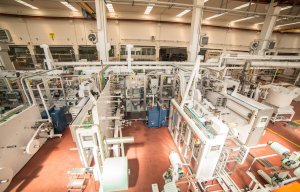
Two diaper lines for Nigeria
Opinion


The adoption of cellulosic materials to replace synthetics will be a key theme at the leading nonwoven show in Geneva this October.

12th August 2021
Adrian Wilson
|
Geneva, Switzerland
The loblolly pine has had a unique role in the development of the absorbent hygiene products (AHPs) industry.
Primarily native to the lowlands and swampy areas of the South-eastern United States, from East Texas to Florida, the tree’s name derives from the old slang words “lob” – for the thick, heavy bubbling of cooking porridge, and “lolly” – for a broth or soup. A loblolly is a mudhole, where this pine is happy to flourish.
The second-most common species of tree in the United States after the red maple, the loblolly pine has been widely used as the basis for much of the fluff pulp employed in AHP absorbent cores since the 1920s.
From the 1980s, however, the development of airlaid, nonwovens also based on such southern bleached softwood kraft (SBSK) pulps, as well as the coarser northern equivalent – NBSK – cultivated across Scandinavia, as well as in Canada and Russia, provided improved bulk, porosity, strength, softness and water absorption to AHPs, leading to a reduction of the fluff pulp needed in the core.
The introduction of superabsorbent polymers (SAPs) subsequently saw the content of fluff pulp in the cores of these products fall further. SAPs have been largely responsible for the significant weight reductions that have subsequently been achieved across the AHP industry and fluff pulp in cores has fallen over the past few decades from around 55% to single figures and sometimes even zero.
At INDEX 2020, however, from October 19-22, it will become abundantly clear that pulp as a raw material is far from over as far as the nonwovens industry is concerned, in the wider general adoption of cellulosic materials to replace synthetics.
The combination of pulp with staple fibres is now especially prominent in the production of wipes that are both more cost effective and at the same time can be plastics-free and biodegradable.
CAC
In February this year, for example, INDEX 2020 exhibitor Mondi started up its new CAC (carded-airlaid-carded) line at its plant in Aschersleben, Germany.

“This is the first machine of its type producing nonwovens based on composites of staple fibre and airlaid pulp,” said the company’s director of R&D Michael Trinkaus, during the online 2021 EDANA Outlook conference. “The nonwoven layers are combined by hydroentanglement without the use of binders to produce materials that are 100% renewable, biodegradable and compostable.”
The resulting nonwovens for wipes are tough on mess, while being gentle to the touch, with a stable 3D texture, he added.
The viscose and pulp combination also results in a high surface area. Other advantages include the pattern stability of the materials made by the CAC progress, with the short fibres strongly positioned by the hydro-moulding step. This also ensures the lotion in wipes stays where it should.
“Going forward, we will explore other combinations of natural fibres, with the Danweb airlay unit capable of handling any short fibres,” Trinkaus said. “The biggest advantage of these new nonwovens is their biodegradability and ability to disintegrate within a month, as has been proven in a peer reviewed LCA.”
neXline wetlace
A number of INDEX 2020 technology exhibitors now have dedicated machine systems for such production.
Andritz Nonwovens, for example, has developed the neXline wetlace CP for the carded pulp process, based on a wetlaid forming unit, and bonding by hydroentanglement for the production of double-layer biodegradable wipes based on pulp and cellulosic fibres.
In order to create a three-layer wipe, an additional card can be added to the carded-pulp process. This opens the door to fibre mixtures with even higher added value and offers high and stable functions while using only biodegradable raw materials. A pulp layer in the middle is perfectly surrounded by the carded nonwoven layers.
Following a strong collaboration, Andritz is currently supplying one of these new lines to Lotus Teknik, part of the Istanbul-headquartered Sapro Group. One of the top three producers of wet wipes globally, Sapro produces, converts and supplies some 120 million wipes a day for personal, household, and industrial use.
WLS
Trützschler Nonwovens has also introduced a carded pulp solution using its AquaJet spunlaced technology and a number of years ago, in partnership with Voith, introduced the WLS wetlaid/spunlace line using a cellulose-based blend of pulp and short lyocell or viscose fibres,.
The company’s latest CP development takes the WLS concept one step further by combining a wetlaid, pulp-based web with a carded web made using longer viscose or lyocell fibres. The wetlaid pulp provides the required absorbency and additional volume to the nonwoven, while the web enhances the softness and wet strength. The AquaJet’s high-pressure water jets bond both layers into a functional nonwoven.
The CP production line features an NCT high-speed card between Voith’s HydroFormer wet web former and the AquaJet. This configuration is highly flexible – the card can be bypassed to produce a WLS nonwoven using only the HydroFormer and AquaJet, without the wetlaying process a classic carded, hydroentangled nonwoven can be made, or the HydroFormer, NCT card and AquaJet can all be used to produce a two-layer CP nonwoven.
Trützschler reports that its Poland-based customer Ecowipes has seen strong demand for the nonwovens produced using a CP line that was installed in Autumn 2020.

Business intelligence for the fibre, textiles and apparel industries: technologies, innovations, markets, investments, trade policy, sourcing, strategy...
Find out more